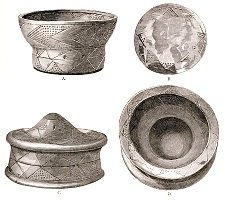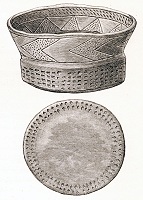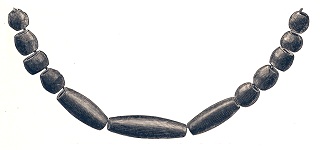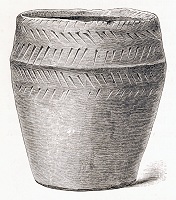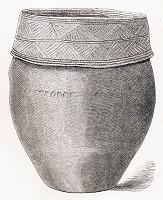Glossary
of some of the
Archaeological terms used in this website.
Archaeological terms used in this website.
A fossilised tree
resin sometimes used to make jewelry such as beads.
These are smallish
pottery vessels that are often known as 'drinking cups' because of their general
resemblance to modern cups, beakers or mugs and were often decorated with incised
chevrons and hatching or by pressing twisted cords into the wet clay. Often found
in association with burials it is thought that they originated in Europe and it
is suggested that different styles were brought over by successive waves of settlers
during the late Neolithic or early Bronze Age onwards, they give their name to
the 'Beaker Culture' that these incomers introduced to the British Isles.
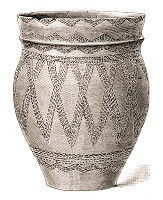
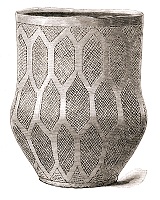
A pair of
beakers from Folkton, North Yorkshire
An alloy of copper
and tin first used in Britain towards the end of the 3rd millennium BC
for tools, decoration, axes, daggers, swords and pins and giving its name
to the period we now know as the Bronze Age. The two material were mixed
in the quantities of 88% copper 12% tin and heated to around 1200 degrees
centigrade before the molten metal was poured into clay or stone moulds.
These were then broken open and the item polished, ground or sharpened
to make the finished article.
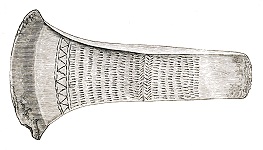
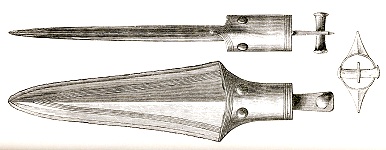
Bronze Flat
Axe
Bronze Tanged
and Collared Spearhead
In Britain the Bronze
Age is estimated to be about 2300BC to 700BC when bronze was the major material
in the construction of tools and weapons, it can be roughly divided into Early
(2300BC-1400BC), Middle (1400BC-1000BC) and Late (1000BC-700BC) phases. Many of
the innovations of the Neolithic are continued, farming becomes more intensive
and whole areas of productive land are set aside with banks, ditches and dykes
marking out 'field systems'. The building of stone circles and erecting of standing
stones continues although this tradition seems to die out around 1200BC while
the Neolithic custom of communal burials in long barrows gives way to smaller
round barrows often with only a single burial or occasionally secondary burials
inserted into the side of the barrow mound. It seems that the status of the individual
becomes more important at this time and some burials are accompanied with rich
grave goods and it could be that we are seeing the emergence of a powerful elite
group of chieftains and warriors that later become the well known tribes of the
Iron Age.
The Bronze Age was preceded by the Neolithic (New Stone Age) which started around 4500BC and was followed by the Iron Age which ran from 700BC to the coming of the Romans in AD43.
The Bronze Age was preceded by the Neolithic (New Stone Age) which started around 4500BC and was followed by the Iron Age which ran from 700BC to the coming of the Romans in AD43.
A mound of stones
or small rocks sometimes covering a burial. Most common in stone-rich areas or
upland where they are often found instead of earthen round barrows or long barrows.
Long rectangular mounds of stone are known as 'long cairns' The term comes from
the Gaelic 'carne' meaning a mound of stones.
A large boulder or
stone slab placed on top of a burial chamber. Often precariously balanced, these
stones can weigh several tons.
Carved
Rocks
- See Rock Art
This term can be
used to describe a wide range of stone monuments dating from the Neolithic period
that are characterised by the use of stone slabs and/or drystone walling and capstones
to create a box like 'chamber' intended to house the bones or cremation remains
of the dead. These tombs are then covered with earth or stone and rubble to create
either round mounds, long barrows or cairns. They are most commonly found in upland
or stone-rich areas and there are identifiable regional styles. The simplest form
of the monument is the 'portal tomb' or 'dolmen' and consists of a pair of upright
side slabs (the portals) with a smaller stone to the rear supporting a large capstone
and a further upright slab of variable height at the front of the monument creating
a blocking door between the portals - although this stone is often missing from
surviving tombs. The monuments can become more complex with the addition of further
large stones and when a low narrow stone lined passage leading to the chamber
is added this creates a 'passage grave' these are most commonly covered by round
mounds while in 'gallery graves' the passage is often wider, taller and longer
and is more likely to have a rectangular or trapezoidal covering mound. In both
cases there may be additional side chambers which give these monuments the name
of 'transepted' or 'cruciform' graves. Not all of these chambers were necessarily
used for burials and in some cases it seems that the chambers were kept accessible
for long periods of time for fresh burials and that previously deposited bones
were often removed, perhaps for some kind of ritual activity, before being redeposited
in the tomb.
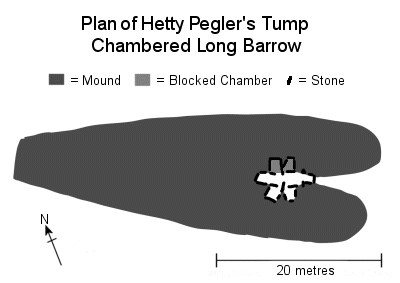
Plan of a Chambered
Long Barrow - Hetty Pegler's Tump, Gloucestershire
A rectangular or
square stone grave, sometimes excavated in rock or laying above the ground, with
a stone lid and often covered by a barrow.
The most common and
simplest prehistoric rock carving. Cups consist of a small roughly circular depression
chipped out of a stone using either an antler pick or hard hammer stone. They
may have one or more surrounding rings around them and are then known as 'cup
and ring' designs. Cups are found either singly or more commonly in groups often
in association with other more complex carvings.
See also Rockart
See also Rockart
A long track or avenue
with parallel banks and external ditches and closed at the either end by further
banks and ditches, they may be some kind of processional way. Built during the
Neolithic they are usually associated with long barrows, the term 'cursus' was
given to these monuments by William Stukeley and is Latin for 'racecourse'.
Dolmen
- See Chambered
Tomb
Often used for beads
and similar jewelry, faience is made by mixing sand or quartz with lime or ash
into a paste and then heating until the mixture fuses together into a glass-like
material. During this process, known as sintering, other materials can be added
for colouration, such as copper to create the bluish-green faience often found
in Britain.
Flint is a hard fine
grained rock formed in chalk beds that can be shaped into very sharp tools
such as knives, scrapers and arrow heads by an experienced worker in a
process called knapping. Flint was often mined in large quantities at
places such as Grimes Graves in Norfolk and its strength and resilience
means many fine examples have survived to the present day.
These are more common
in the east of the country and consist of a style of flat bottomed bowl-like pottery
made of thick clay with a pronounced collar and rim and often covered with simple
decoration. While they are often found as fragments they may survive intact within
a burial mound - although they are sometimes found smashed instead, perhaps deliberately
during the burial ritual.
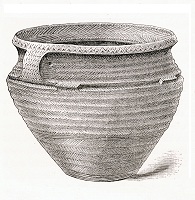
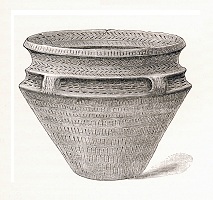
A pair of Food
Vessels from Yorkshire
Unique to Britain,
a henge is a Neolithic or early Bronze Age circular enclosure, up to 400 metres
across with banks and usually an internal ditch. There are different types of
henges: Class I have a single entrance, Class II have 2 opposing entrances and
those that contain stone circles are known as circle-henges. Many henges have
been found to have contained pits and burials as well as circles of timber posts
while others such as Durrington Walls even seemed to have had timber buildings
constructed within them.

This term covers
a variety of different structures that first date from the late Bronze Age but
flourished during the subsequent Iron Age. They are characterised as fortified
enclosures consisting of ditches and banks (ramparts) either of earth, wood or
stone, or sometimes a mixture of all of these with one or more defendable entrances.
Those with one set of defences are known as 'univallate' while 'multivallate'
sites have two or more lines of ramparts and ditches. Hillforts are thought to
have had many uses, as well as being symbols of prestige and power for local chiefs
some were probably designed to offer protection during times of inter tribal tension
and traces of dwellings have been excavated at some sites, while they could also
have served as storage and distribution centres for surplus grain or the herding
of livestock.
Small pottery vessels
from the Bronze Age that are sometimes found in association with urns and cremations.
Most are small enough to fit in the palm of a hand, are plainly decorated and
have holes in their sides. It has been suggested that they may have been used
to burn aromatic herbs during burial or cremation rituals but their true purpose
remains a mystery.
A pair of incense
cups from Aldbourne, Wiltshire
The act of burying
a human body as opposed to cremation.
The Iron Age is considered
in Britain to be the period from about 700BC to the coming of the Romans
in AD43, it takes its name from the first use of iron as a material for
weapons and tools although bronze continued to be used for many items.
We begin to see close links with continental Europe and it has traditionally
been though that Britain was subject to waves of invasion or immigration
- these theories have now given way to the belief that it was the spread
of ideas and customs that came into the country rather than a mass influx
of people, although there is some evidence for settlement in southern
England and East Yorkshire. The population was indeed increasing during
this time though and we see the rise of regional tribal groups or chiefdoms
as well as a continuation of the dividing up of land for either territorial
reasons or for farming. There is also much evidence of settlement such
as 'round houses' which sometimes formed small villages, ditched defended
camps or farmsteads, brochs and crannogs in Scotland, and massive hillforts
which may have had other uses such as regional trade centres, the storage
of grain, or seats of power.
The previous traditions of building funeral barrows now ceases (except in parts of Yorkshire) and although graves are sometimes found it seems that cremation followed by a scattering of the remains is the preferred method of handling the dead. These rituals could have taken place in streams, rivers or wet or boggy places and these same places were also used for the deposition of what are thought to be 'votive' offerings to the gods or spirits of such things as shields and weapons. The ceremonies could have been officiated over by religious leaders we know today as druids - however what little we know of these people comes to use from Roman accounts and we must be wary of the fact that these descriptions may be subject to the political bias of the time.
The previous traditions of building funeral barrows now ceases (except in parts of Yorkshire) and although graves are sometimes found it seems that cremation followed by a scattering of the remains is the preferred method of handling the dead. These rituals could have taken place in streams, rivers or wet or boggy places and these same places were also used for the deposition of what are thought to be 'votive' offerings to the gods or spirits of such things as shields and weapons. The ceremonies could have been officiated over by religious leaders we know today as druids - however what little we know of these people comes to use from Roman accounts and we must be wary of the fact that these descriptions may be subject to the political bias of the time.
A black material
similar to coal formed by the fossilisation of wood under high geological pressure.
Most famously found around the Whitby area of North Yorkshire it has been carved
and polished to make jewelry since prehistoric times.
Jet beads from
the Fylingdales area
This is a rectangular
or trapezoid mound built during the Neolithic (New Stone Age) and nearly always
associated with burial remains. Many are oriented with a higher end facing roughly
to the east which contained either a timber mortuary enclosure or stone chambers.
In many cases it seems that this ritual area remained open for long periods of
time - sometimes hundreds of years, for the deposition or removal of remains.
At some point these structures were sealed and covered with earth, rubble or turf
dug from flanking quarry ditches and the structure extended backwards between
20 and 120 metres. Several regional variations in design and methods of construction
occur which seem to be influenced by the availability of local building materials.
This is the time
between the ending of the last Ice Age in Britain and the beginning of the Neolithic.
The ice sheets that had covered much of Britain are though to have receded between
10000-8000 BC allowing groups of hunter-gathers to cross over the land bridge
that existed between Britain and continental Europe, here the regenerated grasslands
and forests provided fruit, nuts and berries for the early family groups who also
fished and hunted animals such as deer and wild boar with spears and bows. They
did not create permanent settlements or build earth or stone monuments but seemed
to have moved around the countryside following the herds and creating seasonal
camps which leave little evidence except flint and stone tools and bone waste.
This transient lifestyle slowly gave way to a more settled form of living with
the domestication of animals and the growing of crops starting sometime around
4500BC - the beginning of the Neolithic or New Stone Age.
Middle
Stone Age -
See Mesolithic
The Neolithic or
New Stone Age is the period in time that saw the first move to a settled way of
life for the inhabitants of Europe and the beginning of stock rearing and farming
as well as the first use of pottery items, It is though to have started in Britain
around 4500BC and continued until about 2300BC when the use of bronze for tools
and weapons marked the dawn of what we now know as the Bronze Age. It was also
the start of communities building and erecting earth or stone structures such
as burial chambers, barrows, standing stones and stone circles.
New
Stone Age
- See Neolithic
This is a language
that dates from the 4th -5th centuries and was used mainly in Ireland and Wales.
It uses a series of lines that are often cut into the edge of an object such as
a standing stone to represent letters with many of the remaining inscriptions
being either memorials to the dead or territorial markers. Its use had died out
by the 10th century AD.
Old
Stone Age
- See Paleolithic
A standing stone
set apart from but seemingly related to a stone circle.
This is the period
defined in Britain as from 700000BC to around 10000-8000BC when the retreat of
the ice sheets heralded the end of the last Ice Age. The oldest human remains
in Britain, found at Boxgrove, date from about 500000 years ago but successive
waves of intense cold and more temperate climate changes mean that there was never
a permanent population of the country, rather that early man would migrate here
during warmer periods retreating when cooler temperatures made the land uninhabitable.
These early populations lived a 'hunter gatherer' lifestyle following such animals
as woolly rhinos, mammoths, deer, horses and bison as well as collecting fruits
nuts and berries from wild sources. Tools from this period include wooden spears,
bone harpoons and many types of multipurpose stone 'hand axes', flint scrapers
and knives. The only evidence we have for occupation or settlement sites is from
occasional finds in caves.
Hollowed out stones
used during the Medieval period in times of plague. An infected village would
leave coins in the vinegar filled hollow to pay for food and supplies delivered
from outside in the belief that the vinegar would cleanse the coins and prevent
the spread of infection.
Pygmy
Cups
- See Incense Cup
Cornish term for
a chambered tomb - See also Chambered Tomb
This a style of monument
that probably dates from the early to middle Bronze Age and consists of a circular
low mound of rock or stone generally with a cleared area in the middle. Within
this central area small pits are often found that contain charcoal or occasionally
cremated remains. Sometimes larger stones were set within the inner or outer edges
of the stone bank, these monuments are known as 'kerb cairns' and when these larger
stones are left after later robbing of the cairn material it can be difficult
to distinguish the monuments from small stone circles or other circular stone
structures.
Rock Art is a general
term for any prehistoric marking of a rock surface. These marks can range from
a simple cup to complex designs featuring cups with gutters or ducts running from
them, cups with rings, concentric circles, spirals, single or parallel sets of
grooves, interlinking grooves, grooves that enclose areas and resemble maps, ladder
motifs, chevrons plus other geometric or abstract patterns. The marks were made
by chipping, or 'pecking' the rock surface with a hard tool such as an antler
pick and while cups are the most common design several different types of design
are often found grouped together on the same surface - these can be small or large
boulders, outcrops of rock, standing stones or stones incorporated into barrows
or cairns. There is some debate over when these carvings were created but current
opinion is that the tradition started during the late Neolithic and continued
into the middle Bronze Age although questionable earlier and later examples are
proposed, for this website I've generally used a Bronze Age date for Rock Art
unless the evidence suggests otherwise. What is even less certain is what their
purpose or meaning might have been - there have been many theories suggested that
include their use as ritual or astronomical symbols, shamanic visions, maps, grave
markers, territorial markers or tribal totems.
Remains, monuments
or settlement sites that date from the Roman occupation of Britain between AD43
and AD410 but are not Roman in origin.
A circular form of
burial mound consisting of an earthen or earth and rubble domed structure often
with a surrounding ditch and sometimes an outer bank. The mound would usually
have covered a burial or cremation remains on or just below the original ground
surface. These are the most common prehistoric remains in Britain and could number
over 10000 individual barrows, some are clustered together in barrow cemeteries.
Most date from the early and middle Bronze Age period although there are several
large examples that were built during the preceding Neolithic. The most common
examples are Bowl barrows, other rarer examples include Bell, Saucer, Disc and
Pond barrows, sometimes referred to as fancy barrows."
A large block of
tough sandstone sometimes used to build circles and burial chambers in the south
of England. Examples are the Stonehenge Trilithons and the Avebury Circle
A piece of broken
pottery.
Begun in the late
Neolithic period perhaps as early as 3300BC and continuing into the middle of
the Bronze Age sometime around 1200BC, the stone circles of Britain were built
over some 2000 years although they vary in diameter, size and number of stones
and even shape - some are oval, others are set into earth banks. Depending on
the area they were built in the type of stone also varies, from limestone to the
huge sarsen blocks of Stonehenge and Avebury, while some circles incorporated
special stones such as the quartz rich block that forms one of the Boscawen-un
circle in Cornwall or cup and ring or spiral patterns like Long Meg in Cumbria.
Many circles had associated outliers, often large single or double monoliths that
stood either close to, or at some distance from the main circle, others had lines
or avenues of stones that lead to the circle. These may have had some processionary
value or have been used for astronomical sightings. That some of the stones in
the circles were used for astronomical purposes cannot be doubted, some align
with the rising and setting sun at significant times of the year, others with
the course of the moon so it would seem that one of their roles was as ritual
and meeting places to mark important times in the agricultural year.
Born 1687, died 1765.
The Rev Dr William Stukeley was a Lincolnshire born antiquarian who was one of
the pioneers in the study of British prehistoric monuments. Although Stukeley
visited many sites he is most famous for his work recording (and speculating on
the origins of) Stonehenge and Avebury which he published in the books 'Stonehenge,
a Temple Restored to the British Druids', and 'Abury, a Temple of the British
Druids' in the 1740's
Two upright stones
with a horizontal lintel, such as found uniquely at Stonehenge.
A Latin word used
to describe a burial mound. It is most often found on British Ordnance Survey
maps to mark round barrows or cairns although it is sometimes mistakenly used
to mark long barrows.
A large, flat bottomed,
pottery vessel that is often crudely made with thick walls and simple
exterior decorations dating from the early Bronze Age. They are often
known as Cinerary Urns due to their association with cremated human remains
where ashes and remnants of burnt bones were placed inside them and the
urn then usually placed upside down in the grave. It is possible that
this inverting of the urn was simply to protect the ashes when the grave
was covered with earth or it could be a symbolic act of removing it -
and its contents - from the realm of the 'living' world.
Biconical Urn
(left) and Collared Urn (right)
A piece of stone
used for sharpening tool edges by rubbing. During the Bronze Age it seems that
they were sometimes hung from a cord as decoration although it could just be that
this was a way of preventing such a valuable piece of kit from getting lost.
Scans of pottery
and bronze items are from 'Recent researches in barrows in Yorkshire, Wiltshire,
Berkshire etc' by Rev. William Greenwell 1890
